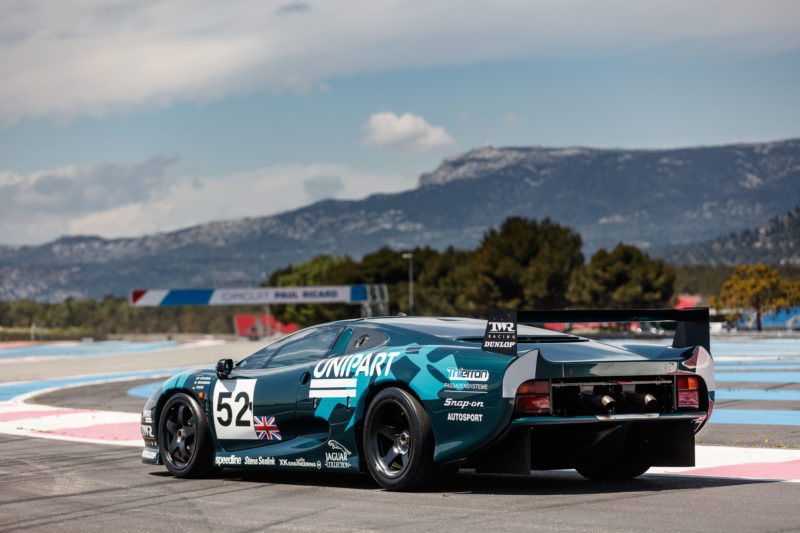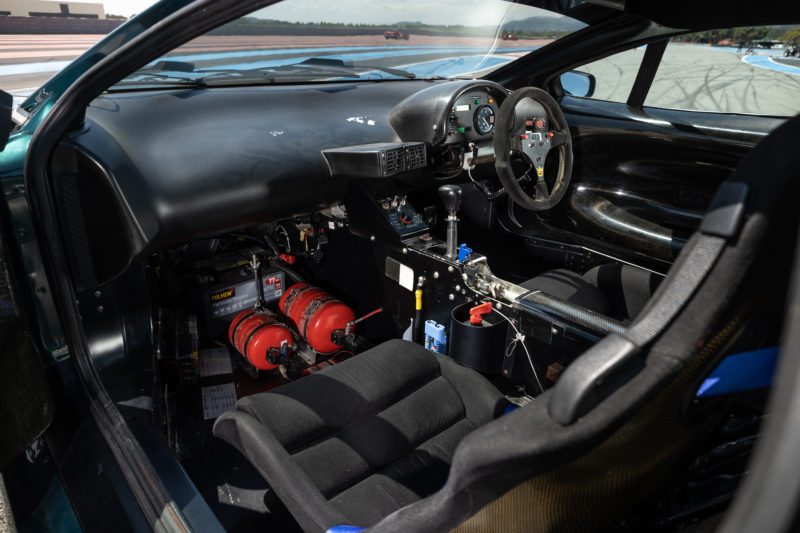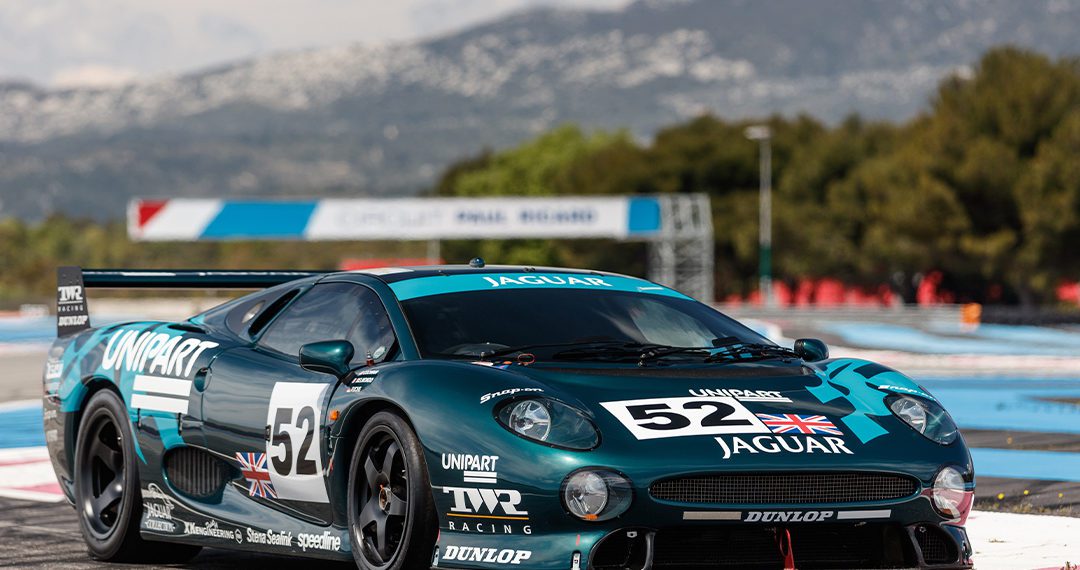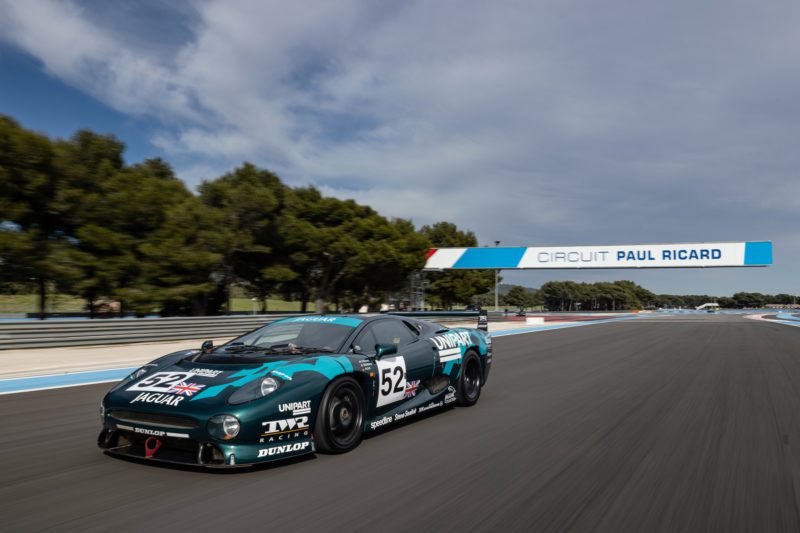Presented by RM Sotheby’s – For the 1993 Le Mans 24 Hours race, a team of three works-supported Jaguar XJ220 Cs were prepared by Tom Walkinshaw Racing, who in 1988 and 1990 had won the race for Jaguar with their mighty XJR-9LM and XJR-12 chassis respectively. TWR was involved in the XJ220 project from the outset via its JaguarSport Ltd. joint venture with Jaguar and had intimate knowledge of the XJ220’s 3.5-liter V-6 engine previously employed in the team’s XJR-10 and XJR-11. Four chassis were diverted to TWR from the XJ220 production line—chassis numbers 220836, 220837, 220838 and 220839—the first three of which were nominated as race cars, and the fourth as a spare. For internal purposes, the race cars were allocated abbreviated serial numbers by TWR of 001, 002 and 003 respectively.
With International Sports Car racing going through a hiatus resulting from the demise of the World Sports Car Championship the previous year, Le Mans would be run as a non-Championship race in 1993 with entries open to a combination of earlier-generation Group C cars, 3.5-liter normally aspirated FIA WSC cars, IMSA WSC cars and production-based GT cars.
This particular car, chassis 220838 (serial no. 003) was to be driven by seasoned IMSA racer Jay Cochran, Formula 1 driver Paul Belmondo, and emerging GT racer Andreas Fuchs, while 001 would be piloted by Armin Hahne, Win Percy, and David Leslie with 002 by former Le Mans winner John Nielsen and Grand Prix drivers David Brabham and David Coulthard. Although 003 was not completed in time, 001 and 002 showed encouraging pace at the Le Mans test day in May, finishing second- and third-fastest in the GT class behind the semi-works Porsche 911 Turbo S of Hans Stuck.

Less than a month later, qualifying for the race itself showed that the XJ220 C’s test day performance was no fluke, with 002 qualifying 2nd in the GT class to the Stuck Porsche once again. With 003 and 001 as third- and fourth-fastest GT qualifiers respectively, TWR approached the race with genuine optimism.
Unfortunately, six laps into the race, 001 suffered a catastrophic cylinder head gasket failure, side-lining that car within 30 minutes of the start. Meanwhile, Stuck’s Porsche developed a sticking throttle after only two hours, costing five laps to repair and promoting 002 and 003 to 1st and 2nd in class as night fell. TWR’s eventful race continued with the Nielsen/Brabham/Coulthard car relinquishing the class lead to 003 in order to repair a serious fuel leak, while Fuchs in 003 later suffered a high-speed tire failure on the Mulsanne Straight which caused him to spin through 360 degrees, albeit mercifully without hitting anything. Despite carefully limping the car back to the pits, terminal damage had been done to the cooling system as a result of the blow out, and the 003 crew were forced to retire after 176 laps.
Serial number 002 would valiantly recover from its unplanned pit stop to regain the GT class lead and cross the line in a fine 15th place overall and 1st in the GT class, only to fail post-race scrutinizing as a result of not having catalytic converters fitted, resulting in a disqualification. Number 003 returned to Le Mans in 1995 as part of a two-car team run by privateer squad PC Automotive, although from the outset it was clear that the GT racing landscape was very different from 1993. Ranged against the XJ220 C in the GT1 class were seven new McLaren F1 GTRs, three Ferrari F40 LM/GTE variants and three Porsche 911 RSRs—not to mention assorted Venturis, Nissan GTR-LMs and a Lister Storm. Qualifying confirmed the team’s suspicions: although they had improved 003’s best lap time from 1993 by almost two seconds, in two years they dropped from qualifying 3rd in class to 14th. Heavy rain fell for much of the race, which played to McLaren’s strengths. Having battled throughout the race—and run as high as 4th in class—003 succumbed once again to engine failure after 135 laps.
Serial number 003 eventually passed into the collection of an active member of the Jaguar Car Club of Japan. Unfortunately, during his ownership, the car was involved in an accident and sustained damage to the front, right hand side. It was subsequently sent to the renown XJ220 specialists at Don Law Racing in the U.K. to be fully repaired and restored to its 1993 Le Mans livery at a cost of nearly £200,000. Acquired by Mr. Guikas in February of 2020, this represents a rare opportunity to acquire a bona fide works Jaguar—and two-time Le Mans competitor—from the golden years of GT racing which is highly eligible for a variety of racing series across the globe, including Endurance Racing Legends, Master Endurance Legends and Le Mans Classic. The car will be delivered with the ACO scrutineering forms.

Much rare than a F40 LM, this is a fantastic opportunity for the next owner to show up at the track with a masterpiece.
RM Sotheby’s will present this vehicle as part of a single-owner collection comprised of 75 of the finest racing and road cars in the world, offered entirely without reserve. The Guikas Collection, to be sold at Paul Ricard Circuit in France in November 2021, presents pedigrees spanning from the endurance racing of the 24 Hours of the Le Mans to the world stage of Formula One and nearly everything in between. The collection of race cars will provide modern racing enthusiasts an introduction into virtually all vintage racing series worldwide, including GT and road cars that are equally impressive which offer a wide selection of Pre- and Post War sports cars.












